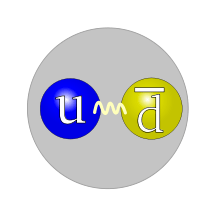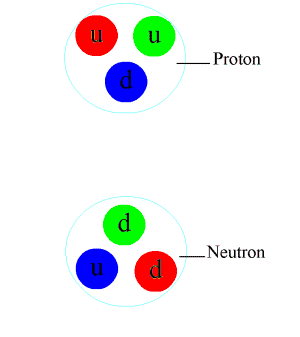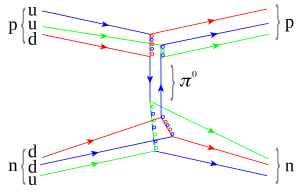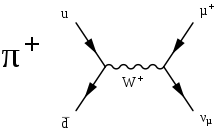Pion
In particle physics, a pion (or a pi meson, denoted with the Greek letter pi:
π
) is any of three subatomic particles:
π0
,
π+
, and
π−
. Each pion consists of a quark and an antiquark and is therefore a meson. Pions are the lightest mesons and, more generally, the lightest hadrons. They are unstable, with the charged pions
π+
and
π−
decaying after a mean lifetime of 26.033 nanoseconds (2.6033×10−8 seconds), and the neutral pion
π0
decaying after a much shorter lifetime of 84 attoseconds (8.4×10−17 seconds). Charged pions most often decay into muons and muon neutrinos, while neutral pions generally decay into gamma rays.
 The quark structure of the pion. | |
| Composition | π+ : u d π0 : u u or d d π− : d u |
|---|---|
| Statistics | Bosonic |
| Interactions | Strong, Weak, Electromagnetic, and Gravity |
| Symbol | π+ , π0 , and π− |
| Antiparticle | π+ : π− π0 : self |
| Theorized | Hideki Yukawa (1935) |
| Discovered | César Lattes, Giuseppe Occhialini (1947) and Cecil Powell |
| Types | 3 |
| Mass | π± : 139.57018(35) MeV/c2 π0 : 134.9766(6) MeV/c2 |
| Mean lifetime | π± : 2.6×10−8 s, π0 : 8.4×10−17 s |
| Electric charge | π+ : +1 e π0 : 0 e π− : −1 e |
| Color charge | 0 |
| Spin | 0 |
| Parity | −1 |
The exchange of virtual pions, along with vector, rho and omega mesons, provides an explanation for the residual strong force between nucleons. Pions are not produced in radioactive decay, but commonly are in high energy collisions between hadrons. Pions also result from some matter-antimatter annihilation events. All types of pions are also produced in natural processes when high energy cosmic ray protons and other hadronic cosmic ray components interact with matter in Earth's atmosphere. In 2013, the detection of characteristic gamma rays originating from the decay of neutral pions in two supernova remnants has shown that pions are produced copiously after supernovas, most probably in conjunction with production of high energy protons that are detected on Earth as cosmic rays.[1]
The concept of mesons as the carrier particles of the nuclear force was first proposed in 1935 by Hideki Yukawa. While the muon was first proposed to be this particle after its discovery in 1936, later work found that it did not participate in the strong nuclear interaction. The pions, which turned out to be examples of Yukawa's proposed mesons, were discovered later: the charged pions in 1947, and the neutral pion in 1950.
History


Theoretical work by Hideki Yukawa in 1935 had predicted the existence of mesons as the carrier particles of the strong nuclear force. From the range of the strong nuclear force (inferred from the radius of the atomic nucleus), Yukawa predicted the existence of a particle having a mass of about 100 MeV/c2. Initially after its discovery in 1936, the muon (initially called the "mu meson") was thought to be this particle, since it has a mass of 106 MeV/c2. However, later experiments showed that the muon did not participate in the strong nuclear interaction. In modern terminology, this makes the muon a lepton, and not a meson. However, some communities of astrophysicists continue to call the muon a "mu-meson".
In 1947, the first true mesons, the charged pions, were found by the collaboration of Cecil Powell, César Lattes, Giuseppe Occhialini, et al., at the University of Bristol, in England. Since the advent of particle accelerators had not yet come, high-energy subatomic particles were only obtainable from atmospheric cosmic rays. Photographic emulsions based on the gelatin-silver process were placed for long periods of time in sites located at high altitude mountains, first at Pic du Midi de Bigorre in the Pyrenees, and later at Chacaltaya in the Andes Mountains, where the plates were struck by cosmic rays.
After the development of the photographic plates, microscopic inspection of the emulsions revealed the tracks of charged subatomic particles. Pions were first identified by their unusual "double meson" tracks, which were left by their decay into a putative meson. The particle was identified as a muon, which is not typically classified as a meson in modern particle physics. In 1948, Lattes, Eugene Gardner, and their team first artificially produced pions at the University of California's cyclotron in Berkeley, California, by bombarding carbon atoms with high-speed alpha particles. Further advanced theoretical work was carried out by Riazuddin, who in 1959, used the dispersion relation for Compton scattering of virtual photons on pions to analyze their charge radius.[2]
Nobel Prizes in Physics were awarded to Yukawa in 1949 for his theoretical prediction of the existence of mesons, and to Cecil Powell in 1950 for developing and applying the technique of particle detection using photographic emulsions.
Since the neutral pion is not electrically charged, it is more difficult to detect and observe than the charged pions are. Neutral pions do not leave tracks in photographic emulsions or Wilson cloud chambers. The existence of the neutral pion was inferred from observing its decay products from cosmic rays, a so-called "soft component" of slow electrons with photons. The
π0
was identified definitively at the University of California's cyclotron in 1950 by observing its decay into two photons.[3] Later in the same year, they were also observed in cosmic-ray balloon experiments at Bristol University.
The pion also plays a crucial role in cosmology, by imposing an upper limit on the energies of cosmic rays surviving collisions with the cosmic microwave background, through the Greisen–Zatsepin–Kuzmin limit.
In the standard understanding of the strong force interaction as defined by quantum chromodynamics, pions are loosely portrayed as Goldstone bosons of spontaneously broken chiral symmetry. That explains why the masses of the three kinds of pions are considerably less than that of the other mesons, such as the scalar or vector mesons. If their current quarks were massless particles, it could make the chiral symmetry exact and thus the Goldstone theorem would dictate that all pions have a zero mass. Empirically, since the light quarks actually have minuscule nonzero masses, the pions also have nonzero rest masses. However, those weights are almost an order of magnitude smaller than that of the nucleons, roughly[4] mπ ≈ √v mq / fπ ≈ √mq 45 MeV, where mq are the relevant current-quark masses in MeV, around 5−10 MeV.
The use of pions in medical radiation therapy, such as for cancer, was explored at a number of research institutions, including the Los Alamos National Laboratory's Meson Physics Facility, which treated 228 patients between 1974 and 1981 in New Mexico,[5] and the TRIUMF laboratory in Vancouver, British Columbia.
Theoretical overview
The pion can be thought of as one of the particles that mediate the interaction between a pair of nucleons. This interaction is attractive: it pulls the nucleons together. Written in a non-relativistic form, it is called the Yukawa potential. The pion, being spinless, has kinematics described by the Klein–Gordon equation. In the terms of quantum field theory, the effective field theory Lagrangian describing the pion-nucleon interaction is called the Yukawa interaction.
The nearly identical masses of
π±
and
π0
imply that there must be a symmetry at play; this symmetry is called the SU(2) flavour symmetry or isospin. The reason that there are three pions,
π+
,
π−
and
π0
, is that these are understood to belong to the triplet representation or the adjoint representation 3 of SU(2). By contrast, the up and down quarks transform according to the fundamental representation 2 of SU(2), whereas the anti-quarks transform according to the conjugate representation 2*.
With the addition of the strange quark, one can say that the pions participate in an SU(3) flavour symmetry, belonging to the adjoint representation 8 of SU(3). The other members of this octet are the four kaons and the eta meson.
Pions are pseudoscalars under a parity transformation. Pion currents thus couple to the axial vector current and pions participate in the chiral anomaly.
Basic properties
Pions, which are mesons with zero spin, are composed of first-generation quarks. In the quark model, an up quark and an anti-down quark make up a
π+
, whereas a down quark and an anti-up quark make up the
π−
, and these are the antiparticles of one another. The neutral pion
π0
is a combination of an up quark with an anti-up quark or a down quark with an anti-down quark. The two combinations have identical quantum numbers, and hence they are only found in superpositions. The lowest-energy superposition of these is the
π0
, which is its own antiparticle. Together, the pions form a triplet of isospin. Each pion has isospin (I = 1) and third-component isospin equal to its charge (Iz = +1, 0 or −1).
Charged pion decays

The
π±
mesons have a mass of 139.6 MeV/c2 and a mean lifetime of 2.6033×10−8 s. They decay due to the weak interaction. The primary decay mode of a pion, with a branching fraction of 0.999877, is a leptonic decay into a muon and a muon neutrino:
The second most common decay mode of a pion, with a branching fraction of 0.000123, is also a leptonic decay into an electron and the corresponding electron antineutrino. This "electronic mode" was discovered at CERN in 1958:[6]
The suppression of the electronic decay mode with respect to the muonic one is given approximately (up to a few percent effect of the radiative corrections) by the ratio of the half-widths of the pion–electron and the pion–muon decay reactions,
and is a spin effect known as helicity suppression.
Its mechanism is as follows: The negative pion has spin zero; therefore the lepton and the antineutrino must be emitted with opposite spins (and opposite linear momenta) to preserve net zero spin (and conserve linear momentum). However, because the weak interaction is sensitive only to the left chirality component of fields, the antineutrino has always left chirality, which means it is right-handed, since for massless anti-particles the helicity is opposite to the chirality. This implies that the lepton must be emitted with spin in the direction of its linear momentum (i.e., also right-handed). If, however, leptons were massless, they would only interact with the pion in the left-handed form (because for massless particles helicity is the same as chirality) and this decay mode would be prohibited. Therefore, suppression of the electron decay channel comes from the fact that the electron's mass is much smaller than the muon's. The electron is relatively massless compared with the muon, and thus the electronic mode is greatly suppressed relative to the muonic one, virtually prohibited.[7]
Although this explanation suggests that parity violation is causing the helicity suppression, the fundamental reason lies in the vector-nature of the interaction which dictates a different handedness for the neutrino and the charged lepton. Thus, even a parity conserving interaction would yield the same suppression.
Measurements of the above ratio have been considered for decades to be a test of lepton universality. Experimentally, this ratio is 1.230(4)×10−4.[8]
Beyond the purely leptonic decays of pions, some structure-dependent radiative leptonic decays (that is, decay to the usual leptons plus a gamma ray) have also been observed.
Also observed, for charged pions only, is the very rare "pion beta decay" (with branching fraction of about 10−8) into a neutral pion, an electron and an electron antineutrino (or for positive pions, a neutral pion, a positron, and electron neutrino).
The rate at which pions decay is a prominent quantity in many sub-fields of particle physics, such as chiral perturbation theory. This rate is parametrized by the pion decay constant (ƒπ), related to the wave function overlap of the quark and antiquark, which is about 130 MeV.[9]
Neutral pion decays
The
π0
meson has a mass of 135.0 MeV/c2 and a mean lifetime of 8.4×10−17 s.[10] It decays via the electromagnetic force, which explains why its mean lifetime is much smaller than that of the charged pion (which can only decay via the weak force).

The dominant
π0
decay mode, with a branching ratio of BR2γ = 0.98823 , is into two photons:
π0→ 2
γ
.
The decay
π0
→ 3
γ
(as well as decays into any odd number of photons) is forbidden by the C-symmetry of the electromagnetic interaction: The intrinsic C-parity of the
π0
is +1, while the C-parity of a system of n photons is (−1)n.
The second largest
π0
decay mode ( BRγee = 0.01174 ) is the Dalitz decay (named after Richard Dalitz), which is a two-photon decay with an internal photon conversion resulting a photon and an electron-positron pair in the final state:
The third largest established decay mode ( BR2e2e = 3.34×10−5 ) is the double-Dalitz decay, with both photons undergoing internal conversion which leads to further suppression of the rate:
π0→
e−+
e++
e−+
e+
.
The fourth largest established decay mode is the loop-induced and therefore suppressed (and additionally helicity-suppressed) leptonic decay mode ( BRee = 6.46×10−8 ):
π0→
e−+
e+
.
The neutral pion has also been observed to decay into positronium with a branching fraction on the order of 10−9. No other decay modes have been established experimentally. The branching fractions above are the PDG central values, and their uncertainties are omitted, but available in the cited publication.[10]
| Particle name | Particle symbol |
Antiparticle symbol |
Quark content[11] |
Rest mass (MeV/c2) | IG | JPC | S | C | B' | Mean lifetime (s) | Commonly decays to (>5% of decays) |
|---|---|---|---|---|---|---|---|---|---|---|---|
| Pion[8] | π+ |
π− |
u d |
139.570 18 ± 0.000 35 | 1− | 0− | 0 | 0 | 0 | 2.6033 ± 0.0005 × 10−8 | μ+ + ν μ |
| Pion[10] | π0 |
Self | [a] | 134.976 6 ± 0.000 6 | 1− | 0−+ | 0 | 0 | 0 | 8.4 ± 0.6 × 10−17 | γ + γ |
See also
References
- Ackermann, M.; et al. (2013). "Detection of the characteristic pion-decay signature in supernova remnants". Science. 339 (6424): 807–811. arXiv:1302.3307. Bibcode:2013Sci...339..807A. doi:10.1126/science.1231160. PMID 23413352.
- Riazuddin (1959). "Charge radius of the pion". Physical Review. 114 (4): 1184–1186. Bibcode:1959PhRv..114.1184R. doi:10.1103/PhysRev.114.1184.
- Bjorklund, R.; Crandall, W.E.; Moyer, B.J.; York, H.F. (1950). "High Energy Photons from Proton-Nucleon Collisions" (PDF). Physical Review. 77 (2): 213–218. Bibcode:1950PhRv...77..213B. doi:10.1103/PhysRev.77.213. hdl:2027/mdp.39015086480236.
- Gell-Mann, M.; Renner, B. (1968). "Behavior of current divergences under SU3×SU3" (PDF). Physical Review. 175 (5): 2195–2199. Bibcode:1968PhRv..175.2195G. doi:10.1103/PhysRev.175.2195.
- von Essen, C.F.; Bagshaw, M.A.; Bush, S.E.; Smith, A.R.; Kligerman, M.M. (1987). "Long-term results of pion therapy at Los Alamos". International Journal of Radiation Oncology * Biology * Physics. 13 (9): 1389–1398. doi:10.1016/0360-3016(87)90235-5. PMID 3114189.
- Fazzini, T.; Fidecaro, G.; Merrison, A.; Paul, H.; Tollestrup, A. (1958). "Electron Decay of the Pion". Physical Review Letters. 1 (7): 247–249. Bibcode:1958PhRvL...1..247F. doi:10.1103/PhysRevLett.1.247.
- Mesons at Hyperphysics
- C. Amsler et al.. (2008): Particle listings –
π± - Leptonic decays of charged pseudo- scalar mesons J. L. Rosner and S. Stone. Particle Data Group. December 18, 2013
- Amsler, C.; et al. (Particle Data Group) (2008). "Particle listings –
π0
" (PDF). Lawrence Berkeley Laboratory. - Amsler, C.; et al. (Particle Data Group) (2008). "Quark Model" (PDF). Lawrence Berkeley Laboratory.
- Griffiths, D.J. (1987). Introduction to Elementary Particles. John Wiley & Sons. ISBN 0-471-60386-4.
Further reading
- Gerald Edward Brown and A. D. Jackson, The Nucleon-Nucleon Interaction (1976), North-Holland Publishing, Amsterdam ISBN 0-7204-0335-9
External links
- Mesons at the Particle Data Group